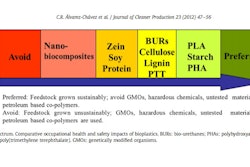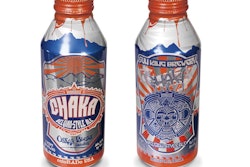
Plantic Technologies of Melbourne, Australia, showed two commercial applications of its Plantic eco Plastic high-barrier technology. From Excelline Food Products of Chatsworth, CA, comes super-premium Steak and Green Chili Flautas in a tray (shown here) that Excelline forms from rollstock provided by Plantic. And in a pre-made tray supplied by Plantic comes Outback Spirit Sausages from Farmfoods Australia of Geelong, Victoria, Australia; the tray is notable for its custom-matched “Outback orange” color. Both of these innovative packs have extended refrigerated shelf lives. As of this posting, no information was available regarding lidding materials, but presumably some barrier material is involved.
Plantic eco Plastic is made using a corn crop that is specifically grown for Plantic Technologies Ltd. The whole of the harvested crop is used and Plantic uses the extracted starch to make its biopolymer packaging material; the byproduct goes to animal food and fertilizer. Due to a highly efficient conversion rate, says Plantic, there is minimal crop space required, and the crop has no impact on food-growing land space requirements. The firm’s patented polymer technology is based on the use of high-amylose corn starch, a material derived from annual harvesting of specialized non-genetically-modified (hybrid) corn and supplied by Corn Products International. The biopolymer is comparable in cost to other conventional plastic packaging materials, says Plantic.
Plantic eco Plastic consists of a core layer that is extruded in a conventional manner. Laminated to this core layer are skin layers of PE or PP. Plantic eco Plastic is not biodegradable due to the presence of non-biodegradable skin layers that surround the starch core. Plantic notes that a process to separate the starch core from the skins has been developed. In the meantime, says Plantic, this material is not considered a significant contaminant in mixed polymer recycling processes. The firm also notes that the material is certified as a bio-based product by Vincotte. The certification of 3 stars indicates that the material is made of up to 89% renewable content.
“The environmental benefits of Plantic eco Plastic™ combined with the ability to meet our shelf life demands provide a package that truly fits with our high standards and naturally fresh image,” says Carlos Angulo, CEO of Excelline Foods. “All of our products are handmade using only the freshest ingredients and natural preservatives to bring our customers the highest quality Mexican foods available.”


























